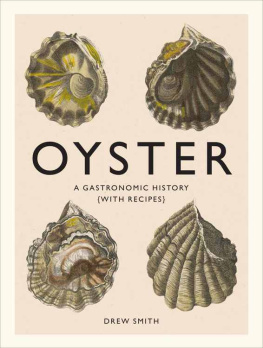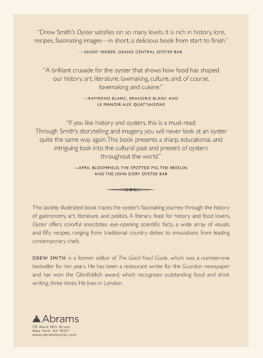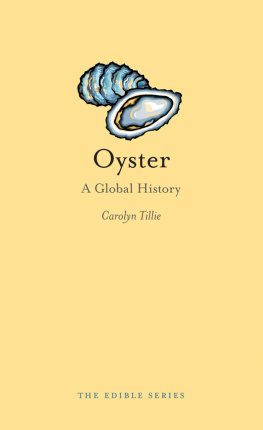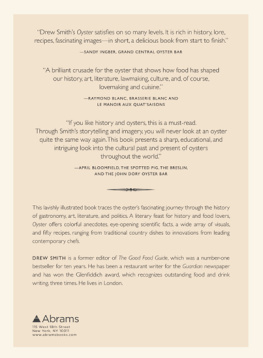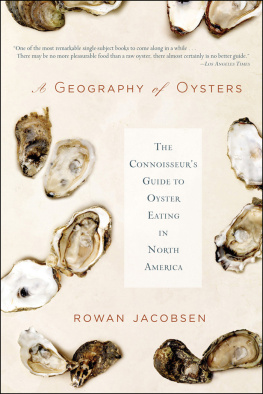
Sunset over oyster farms in Tainan, southern Taiwan.
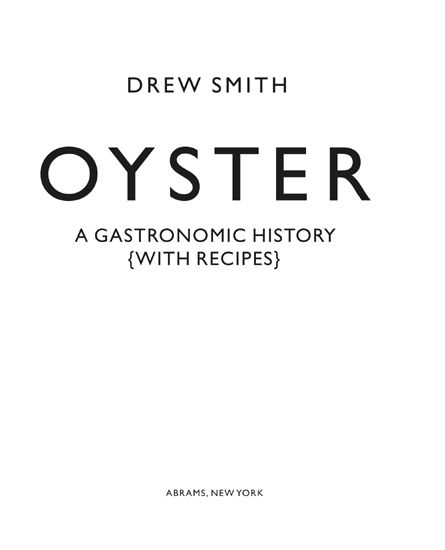
CONTENTS
RECIPES

Osias Beert the Elder, Dishes with Oysters, Fruit, and Wine (detail), c.1620.
FOREWORD
T he Celts did not hold with writing things down; they saw it as weak-minded. The proper storyteller should remember. He should remember things from his father, that came from his father, and from his father... if he could imagine that far backall the way back to New Grange Barrow, on the river Boyne 3,400 BC, perhaps, and probably before that, as if there existed some perpetual line of Druid storytelling that would stretch so far.
The Celts were not the only people who were disadvantaged by not writing things down in this great saga of ours. So let us tell it as if we are moored on a packet boat on a Cornish creek, as the swell of the tide lifts us off the mud; or on a warm Louisiana bayou, drifting, waiting for the wind to get up, or we are waiting to dive from a galley in the Red Sea or off a row boat off Broome, Kimberley, northern Australia.
Waiting, yes, oysters are good at waiting.
Tucked darkly in their calciferous shells, listening warily for dangers, breathing oxygen into the water, sifting the silt, changing sex, the oyster has witnessed all our histories, all our struggles.
Yes, we eat oysters, but that is only one part of our story, their story. The oyster was here before we were. Before once upon a time. Before, you might say, time itself. Back then oyster reefs encircled the continents, a great shelf or ledge between the ocean and the land that we used to haul ourselves up or along, whichever it was, and row ourselves around this planet, cove to cove, not cavemen but covemen.
Take one in your hand, feel the scratch of the shell of what we now call rock, prise it apart and you have Mother Earths chronicle of the planet and a taste of the future.
Treat it with respect.
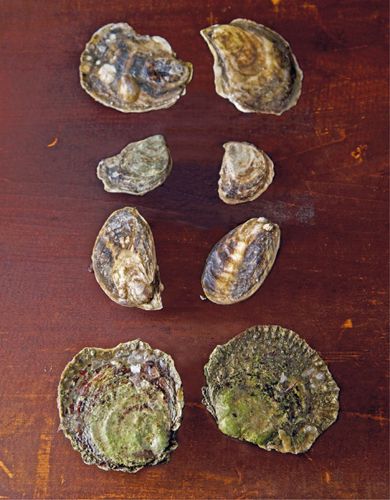
An assortment of fresh oysters. Flavors vary widely, depending on the environmental conditions in which they grow.

ANATOMY OF
AN OYSTER
When the sapid and slippery morselwhich is and is gone like a flash of gustatory summer lightningglides along the palate, few people imagine that they are swallowing a piece of machinery (and going machinery too) greatly more complicated than a watch.
Thomas Huxley
Oysters and the Oyster Question
PERFECT ASYMMETRY
M any things set the oyster apart from other creatures. Most living things are symmetrical. We have two arms and two legs, fish are perfectly aligned left to right, birds have two wings, even most other bivalves have shells that are neatly, roughly equal in size. Not the oyster.
The two sides of an oyster shell are completely different. The top shell is flat, or flatter; the lower side is cupped and sagged because all the conchiolin has leached downward by force of gravity. And even though an oyster may choose to grow vertically as well as horizontally, the effect is the same. The explanation is simple, but it has no parallel in the universe.
The oyster is the one stable creature in an otherwise completely changing estuary environment. Biology has often stalled on the underlying challenge of it being almost impossible to draw precise comparisons between oysters, even of the same species, raised in one estuary to those raised in another, which is another part of their charming uniqueness. Where everything else moves, the oyster stays still.
To early man the oyster had other virtues. It was portable. Bagged up, it could hang off the side of a boat and travel to sea or back home again. Closed up in the shell, the meat stayed fresh and succulent for days. It was wholesome, nutritious food, too, full of energy-giving minerals: calcium for bones, and vitamins that the early diet would have lacked so badly; a source of nutrition far superior to anything else available to wandering Neolithic families.
The oyster was as universal as man, more so in the beginning, whenever that was: Africa, India, Southeast Asia, Japan, China, the Philippines, Australia, New Zealand, all the Americas; so long as there was a coastline, where the waters were neither too salty nor too pure, not too cold nor too hot, the oysters spawned. In Europe they clung to the landmass down from Norway along the North Sea, through the English Channel, around the edges of the French, Spanish, and Portuguese coasts and formed a collar around the Mediterranean.
Can any thing in this world be more foolish than to think that all this rare fabric of heaven and earth can come by chance, when all the skill of art is not able to make an oyster?
Jeremy Taylor, Apples of Sodom
The beds formed a ribbon along the Moroccan coast, penetrated the Black Sea as far as Crimea, and they wrapped themselves around the coast of Ireland. Britain was encircled by oysters even as far north as Orkney. We can presume that Anglo-Saxons survived and were powerful in part because their home on the Frisian peninsula was also an oyster bay.
The semi-salt waters protect the oyster from other predators, and so long as there is a firm rocky footing to gain attachment; so long as the sea currents are not so strong as to destabilize the colonies; so long as the temperatures are not too extreme; and so long as no hurricane comes to muddy the beds, the oyster thrives.
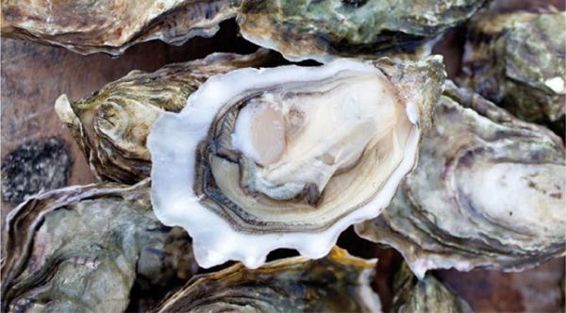
Fresh oysters demonstrating that the top shell is flatter while the lower side is cupped.
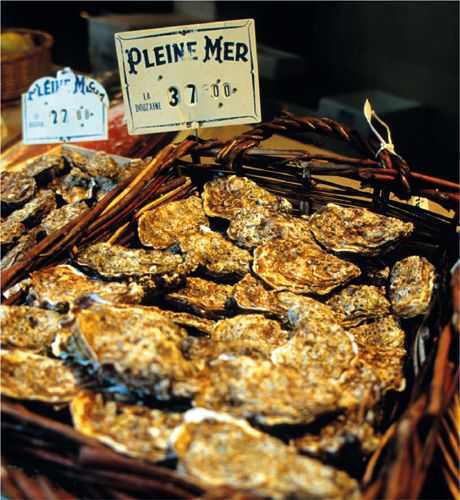
Fresh oysters on a market stall, Deauville, Normandy, France.

OYSTER SOUP
Make this recipe in two stages, preparing the stock the day before eating the soup.
Serves 4
2 tablespoons butter
1 leek, topped, tailed, rinsed and sliced thinly, diagonally
1 carrot, peeled and chopped
1 bunch (3 to 4 ounces/75 to 100 g) fresh parsley, tough stems trimmed
3 cups (750 ml) white wine (see Note)
16 oysters, scrubbed
1 bunch (10 to 12 ounces/250 to 300 g) spinach, tough stems trimmed
4 tablespoons heavy cream
Fresh bread
To make the stock, melt the butter in a large saucepan over medium heat. Add the leek and carrot and sweat the vegetables for 5 minutes. Add the parsley as a bunch and pour in the wine. Shuck half the oysters and add them, with their liquid, to the vegetables and wine. Reduce the heat and simmer for 10 minutes. Take the saucepan off the heat and leave to stand.
Next page
